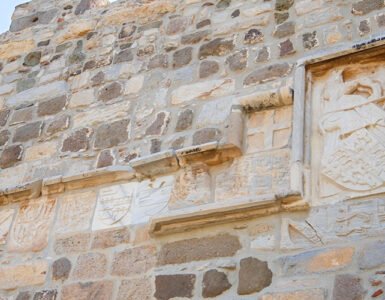Most stories about Bodrum typically begin with the spectacular view of Bodrum Castle. Whether you arrive by water, air, or land, the castle is the first thing to catch your attention as you approach the town.
As well as being the most famous and impressive structure in the area, Bodrum Castle, or the Castle of St. Peter, also contains one of the largest museums of its kind within its walls: the Bodrum Underwater Archaeology Museum.
The castle and the museum are in the same place. The courtyards and buildings in the castle serve as exhibition areas. There’s no need to buy separate tickets for the museum and the castle.
In This Article
The Location of Bodrum Castle
Info Card
Address: Carsi Mahallesi, Kale Caddesi, No: 36 48400 Bodrum, Mugla
Phone: +90 (252) 316 25 16
E-Mail: bodrumsualtiarkeolojimuzesi@kultur.gov.tr
Website: https://muze.gov.tr/muze-detay?SectionId=BSA01&DistId=MRK
Working Hours: Open every day between 08:30 and 17:30. Ticket office closes at 17:00.
Note:
Opening and closing times for the museum can vary depending on the season. It is an open-air museum with various buildings used as exhibition halls. The authorities may change the working hours based on sunset time. For the most updated information, check the official website of the museum or call the ticket office.
Bodrum town extends across two bays running east to west.
The western bay is where people have been living for thousands of years since the Dorians, and locals colloquially refer to this part as the Turkish neighbourhood. The eastern part, on the other hand, is known as the Greek neighbourhood, referring to the relocation of Cretan people of Turkish origin in 1923. During the population exchange, the newcomers settled in this area to avoid potential conflicts with the local population.

A small peninsula, known as Zephyrion in ancient times, separates the Turkish and Greek neighbourhoods, thus the east and the west bays. This is where the Bodrum Castle has been watching over the town for more than 600 years.
Built with Pieces of History
The Knights Hospitaller of Rhodes built three castles in the southeast Aegean, located in Rhodes, Kos, and Smyrna. However, after the Mongol conqueror Timur attacked and destroyed the castle in ancient Smyrna, today’s Izmir, the knights’ control over the territory decreased drastically.
After losing the Smyrna Castle, the knights started searching for a better location to build a new castle on the coast of Anatolia, which was under the control of the Ottoman Empire. They consulted with the reigning sultan, Mehmet I, and received his blessing to build a new stronghold in Bodrum.
Construction began in 1402 on the remains of a smaller castle, built by the Anatolian Beylik of Menteshe. It took almost a century to complete the new castle, marking an important chapter in the history of Bodrum Castle.

What fascinates me the most is that the castle’s architect, Heinrich Schlegelholt, used materials from one of the Seven Wonders of the Ancient World—the Mausoleum at Halicarnassus. After centuries of damage from invasions and earthquakes, the mausoleum provided the stones needed to complete the castle.
If you look closely at the walls of Bodrum Castle, you’ll spot pieces from this ancient wonder. Remarkably, some of these stones were even taken to Malta to finish the Grand Harbour.
The Layout
The Order of the Knights Hospitaller had different divisions called tongues. Each tongue built its own tower and marked them with their own coat of arms. Thus, there are five towers garnishing the medieval scene; the French Tower is the tallest one, measuring 47.50 metres in height. The English Tower, the Italian Tower, the German Tower, and the Spanish Tower, or the Serpentine Tower, are the other towers in the castle.

The castle’s layout is nearly square, measuring 185 by 180 metres. It can be divided into three main sections: the lower section, the upper section, and the entrance/exit area. All the towers are located in the upper section, while the lower section houses service buildings like the bath and chapel.
You can take a look into a more detailed Bodrum Castle Plan which I was prepared for you by clicking here.
Bodrum Castle and The Museum of Underwater Archaeology
Many visitors are confused to learn that Bodrum Castle and the Bodrum Underwater Archaeology Museum refer to the same place. The castle itself is the museum, and they share a common entrance.
Once you have your pass, you can explore the medieval architecture and the amazing artifacts in the exhibition halls.

I love spending time at the castle, which is a peaceful part of my Bodrum routine. There’s nothing better than grabbing a coffee from one of the castle’s cafés and enjoying a book in the tranquil surroundings. I’m sure you’ll find it just as enjoyable.
Visiting Bodrum Castle and the museum multiple times can get expensive if you buy a ticket each time. The solution is to get a Museum Pass from the Ministry of Culture and Tourism, which grants unlimited access to historical sites and museums in Bodrum and across Turkey.
An Arboretum Within the Castle Walls
All the original castle buildings, including the towers and chapel, serve as exhibition spaces. There are also modern structures for fragile collections that need special environmental conditions for preservation.
The courtyards are open-air galleries displaying items like column heads, cannons, anchors, and sarcophagi from local archaeological digs.

As you explore Bodrum Castle, you’ll discover more than just history.
The castle serves as a small arboretum at the same time, home to peacocks, turtles, and various birds. It’s also a paradise for flora lovers, with indigenous plants like daphne and oleander, alongside species from across the Aegean region.
Whether you like history or not, I believe that you would not regret taking the time to visit the Bodrum Castle and the Museum of Underwater Archaeology.
















Add comment